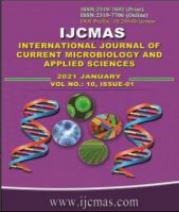


 National Academy of Agricultural Sciences (NAAS)
National Academy of Agricultural Sciences (NAAS)

|
PRINT ISSN : 2319-7692
Online ISSN : 2319-7706 Issues : 12 per year Publisher : Excellent Publishers Email : editorijcmas@gmail.com / submit@ijcmas.com Editor-in-chief: Dr.M.Prakash Index Copernicus ICV 2018: 95.39 NAAS RATING 2020: 5.38 |
Rabbit production is one of the livestock enterprises with the greatest potential and room for expansion in Tamil Nadu. This is because of their minimal investment requirements and ability to reproduce fast. Their feed requirement is low, especially with regard to demand for grain. Hence a frontline demonstration on backyard rabbit rearing was conducted at 5 farmer’s holdings of Kancheepuram district during 2018-19 to demonstrate the scientific rabbit rearing for getting higher yield and income by the farmers. The New Zealand White Rabbit management practices were demonstrated under front line demonstration and it was compared with farmers practice. The results of the demonstration indicated that demonstration of scientific rearing of rabbits recorded higher yield of 990 gms and farmers practice recorded the lower yield of 650 gms. The increase in the weight of rabbit over farmers practice was 50 per cent. The extension gap of 340 gms recorded for marketing body weight of the New Zealand White between demonstration and farmers practice indicated that dissemination of rabbit rearing practices including scientific management practices through demonstration is needed among the rabbit rearers for achieving higher yield thereby income. It was also found that the mortality rate of rabbits was reduced after advising the farmers on scientific rabbit farming practices. Besides, demonstration of scientific rabbit rearing recorded higher net income of Rs.1265 with benefit cost ratio of 2.22 as against farmers practice wherein, the net income was Rs.408 with benefit cost ratio of 1.91 for every rupee investment.
 |
 |
 |
 |
 |